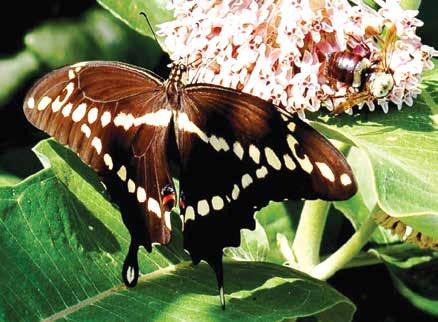Ask the Experts BOXWOOD SHRUBS SHOWING DISTRESS Question: I have several threeyear-old rounded boxwood shrubs and two short vertical boxwood shrubs. All are stressed with some yellowing leaves, especially the verticals. I have been applying a water-soluble fertilizer for three weeks. I put down the spring application of an evergreen food as well. What else do you recommend I might do to save these shrubs? Answer: Fertilizing stressed plants is not recommended. Adding fertilizer pushes new growth when it just needs to focus on surviving. Think about when you are sick, do you want to eat? Many boxwoods are off-color naturally from the extreme cold temperatures in February. The clue for the health of the plant will be if it sprouts any new growth in late April or early May. At this point, no more fertilizer is needed for the rest of the year as this plant really does not need much feeding. A common complaint on boxwoods is they outgrow the space, so I would not recommend fertilizing. My take is that we over fertilizer shrubs in the landscape. If you need help figuring out the cause of the stress, let me know. If it is simply off-color, then this is winter damage, and the plant will recover. In the future, remember fertilizer is seldom recommended for truly struggling plants. SCALE INSECTS HARD TO CONTROL Question: My Saucer Magnolia is covered with what has been diagnosed as scale. How can I get a handle on this pest? Answer: Until the last few years, Magnolia scale was seldom seen in the Kansas City area. Now it seems to be everywhere. Scale insects are difficult to control as the insect has a protective shelllike covering. The covering often shields the pest from insecticides. Scale can be controlled with a one-two punch. Apply a soil drench
Learn strategies for gardening beneath Black Walnut trees.
Looking for inspiration? Shawnee Indian Mission is one of several EMG demonstration gardens available to the public.
systemic insecticide, Imidacloprid, around the base of the plant in late spring through early summer. Then apply dormant oils, an organic option, during the dormant period in late fall through early spring. Oils require thorough coverage to ensure all parts of the plant which can harbor the scales are covered. It may take a couple of years to completely suffocate and bring a heavy infestation under control.
such as tomatoes, potatoes, eggplants, and peppers. Depending on the size of your lot and tree location, vegetable gardens are possible. The walnut roots seek out the moist, fertile vegetable soil. A raised bed is a good option to help combat walnut wilt as it can help reduce root contact. Line the raised beds with a porous landscape fabric material before filling with amended soil to reduce or slow root development into the bed.
or keeping it small. The variety of Bonfire is prized for its bronze leaf color and was not developed to be a fruit producer. It is designed to be a niche tree for a spot of color. If your goal is to produce peaches, look for dwarf varieties that will tolerate our conditions. These trees will be a little bigger than the patio varieties. Plant in a sunny location and provide excellent care. Hopefully, you too, will harvest fresh juicy peaches.
GROWING PEACH TREES A CHALLENGE, DOABLE Question: I am noticing several varieties of dwarf peach trees on the market. One variety that caught my attention is Bonfire, and I have seen others. I really like fresh peaches. Is this an option worth trying? Answer: Dwarf or patio fruit trees are all the rage. I, too, love fresh peaches and have wonderful memories of picking tree-ripe peaches. I have toyed with the idea of planting a dwarf, patio-sized peach tree. These trees grow up to around 8 feet or so, making them perfect for small spaces. Peaches can be finicky to grow. They do not like our heavy clay soils and are prone to spring freezes that nip the buds resulting in no fruit set. Often, with a plant that is dwarfed, it decreases its vig-
VISIT EMG DEMONSTRATION GARDENS FOR INSPIRATION Question: You have referred to your demonstration gardens from time to time. Can you tell me more about these gardens? Answer: I love to share about our network of demonstration gardens in Johnson County, designed and planted by our Extension Master Gardeners (EMG). We have nine locations spread over the county, each with a theme or mission. These range from the popular Monet Garden at the Overland Park Arboretum and Botanical Gardens to a wonderful rain garden/pollinator garden in Fairway at the Shawnee Indian Mission. The gardens, for the most part, are located in public access locations. For a complete listing on themes and locations, visit bit.ly/ jocogardens.
GARDENING NEAR BLACK WALNUT TREE Question: We purchased a new home and are ready to plant our own vegetable garden. There is a black walnut tree in the backyard, and I have heard it creates problems for vegetables. Can I start a garden in my backyard with this tree? Answer: Gardening around black walnuts can be a challenge. A natural toxin called juglone is produced through the leaves, nuts, and roots to reduce competition for resources from other plants. This self-defense mechanism can be harmful to nearby plants causing walnut wilt. In general, the toxic zone around a mature walnut tree is within 50 to 60 feet of the trunk but can extend to 80 feet. The area affected enlarges as the tree grows. Particularly sensitive to juglone are some of our favorite vegetables,
DENNIS PATTON Horticulture Agent 6
May 2021 | kcgmag.com
Dennis Patton is the horticulture agent for Johnson County K-State Research and Extension. For free information fact sheets, visit www.johnson.ksu.edu, or call the Extension office at 913-715-7000.













